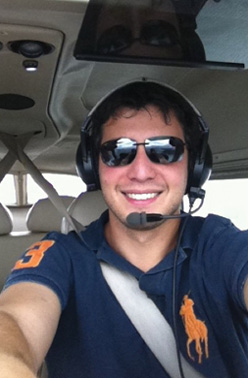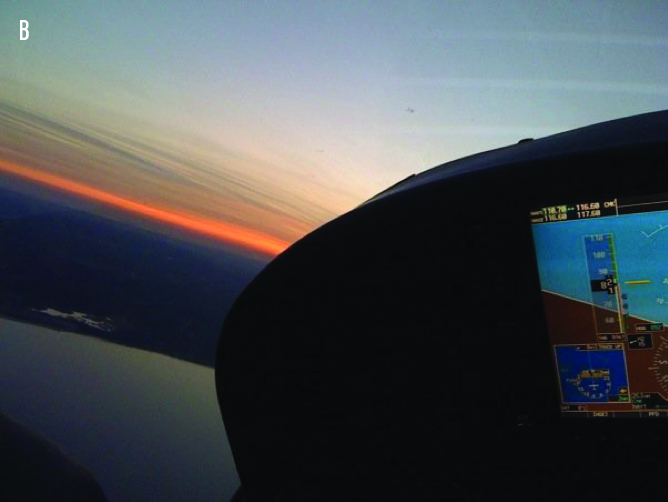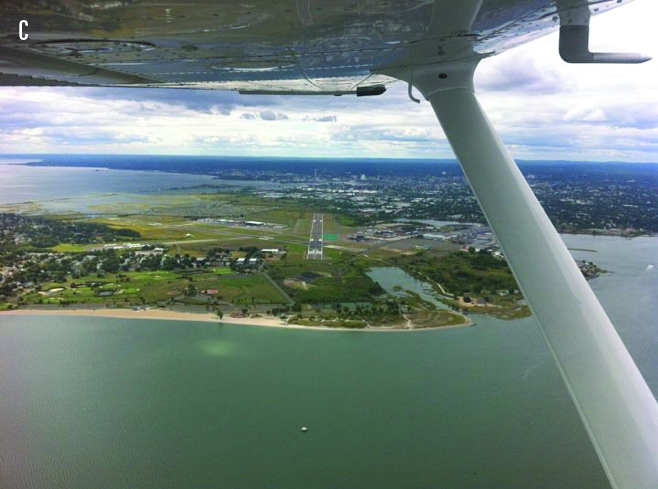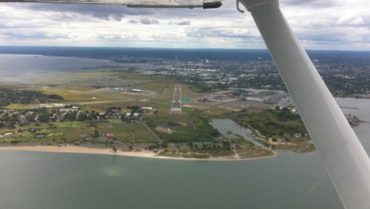
Some people like to escape from the drone of everyday life through an activity that helps them achieve wellness and the right mental health balance. Flying does this for me. And, just as I approach each case in ophthalmology, I hope to excel at flying, one flight at a time (Figure 1).

Figure 1. Dr. Rosenberg appreciates the tranquility that flying provides.
For me, flying has gone hand-in-hand with ophthalmology and engineering since the start of my college years. My passion for flying likely stems from the same amalgamation of physics, mathematics, and imaginative creativity that drew me to ophthalmology. By balancing input and governing output, we challenge ourselves in all aspects of our daily lives, meanwhile enjoying those prized moments when everything comes together.
There is something surreal and sublime about having the unique opportunity and capability to pursue flying as an interest. I look out of the cockpit window and stare into the seam where water meets sky. Harmony here crosses over from the mental to the physical world and balances everything between. There is exhilaration coupled with trepidation when I take off and break that connection to Earth, entering into a 3D environment with the realization that I am the only one in control.
Flying brings me a special kind of enjoyment, and I find it peaceful and relaxing. There are no traffic jams, horns, or New York drivers (at least in the traditional sense). I regularly rent a plane merely to experience the beautiful landscapes as I explore the expanses of Long Island and Connecticut. Driving is a constant test of vigilance, and at times flying is even more so. However, watching the world pass you by from a hawk’s-eye view is tranquility in its premier form (Figure 2).



Figure 2. Aerial photos taken by Dr. Rosenberg in the cockpit. A nighttime flight over the southern shore of Long Island (A), the Jersey Shore at sunset (B), and the Sikorsky Airport in Stratford, Connecticut (C).
Of course, there is a large comfort zone when flying within familiar airspaces, but there is exhilaration in breaking through to “cross-county” flying. Long-distance adventures can bring you to towns, communities, and beachside airports that you would otherwise never have known existed. Pushing my boundaries has taken me from the skies over ski slopes in Pennsylvania to landing amphibious aircraft in the Delaware River. I’ve landed between the ninth and tenth holes on a golf course and played a subsequent round of golf. I’ve been assumed to be a high roller and chauffeured into Atlantic City from the general aviation hanger. The challenge of exploring new territory is met with the sheer enjoyment of expanding your scope.
Some of my friends are afraid to fly, while others are thrilled to partake in the adventures. Most people equate flying with a commercial aircraft 35,000 feet above the ground, idly watching the entire state of Idaho inch by. My wife, on the other hand, frequently likens the single-propeller airplane that I fly to “a Volvo with wings.” Regardless of their stance beforehand, most people I take with me on flights disembark elated, commenting on how great it was and wondering when we can go back up again. The next morning, I find Facebook littered with pictures of the journey. Sharing in the gratification of others is profusely gratifying in itself.
The laws of aerodynamics will never change. Thrust opposes drag, and lift opposes weight and gravity. Despite the many constants in aviation, however, there have been and will continue to be many changes. Although technology is not what makes an airplane fly—there is no replacement for good old-fashioned stick-and-rudder airmanship—automation has updated many error-prone and time-consuming steps. In the past several years, we’ve welcomed glass cockpits, traffic guidance systems, updated materials, and improved aerodynamics. Not unlike ophthalmology, human flight remains a haven for ingenuity and creativity—an engagement that I find hard to resist.
There is no last chapter in aviation. It is a craft that will always keep you learning, no matter your age, time or financial investment, or skill level. Initially learning from instructors, then from peers, I started to notice not only what they were doing, but also what they weren’t doing, and when no intervention is in fact the best intervention. Every step, beginning with igniting the engine, is highly dependent on successfully completing the step before.
The art and science of flying has kept me enthralled, challenged, and humbled. I encourage those who have held back in fear to pursue what drives them in light of the reward that awaits.




